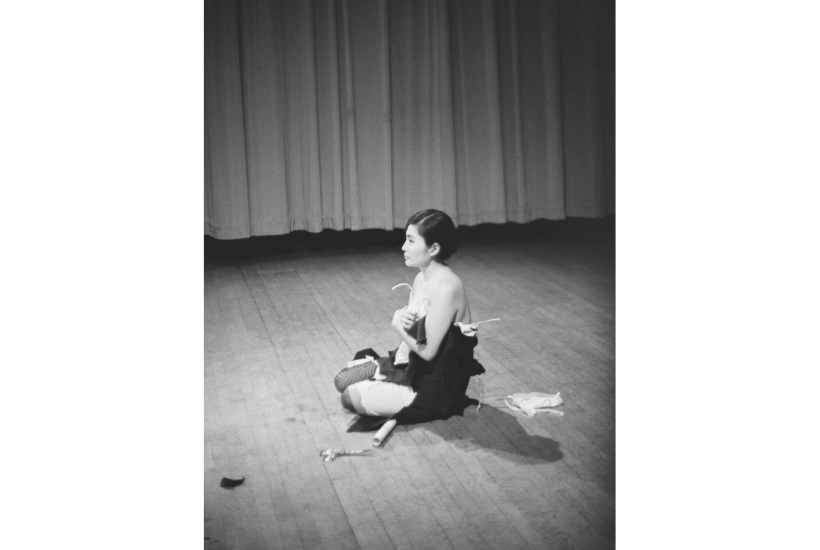The first I heard of Yoko Ono was when my sister’s boyfriend brought home a little book of hers called Grapefruit. It was 1970, four years after John Lennon took the bite out of an apple that led to the break-up of the Beatles. The apple had been on a plinth in Ono’s 1966 exhibition at London gallery Indica with a price tag of £200, for which the purchaser was promised the ‘excitement of watching the apple decay’. Lennon then offered Ono an imaginary five shillings to bang an imaginary nail into her conceptual piece, ‘Painting to Hammer a Nail’ (1961). ‘I met a guy who plays the same game I played,’ she reported.
Ono’s public performances earned her notoriety, but her genius was in her haiku-like ‘instructions’
Lennon is the support act in the 91-year-old artist’s retrospective at Tate Modern: it’s the Yoko show. From the start it establishes her as an avant-gardist in her own right: she was a leading light of the Fluxus movement which staged events at her Chambers Street loft in New York, attended by the likes of Marcel Duchamp, Robert Rauschenberg and Peggy Guggenheim; she toured Japan with John Cage in 1962 and was one of only two women invited to speak at Gustav Metzger’s Destruction in Art Symposium in 1966.
The prototype of today’s international multidisciplinary artist, Ono studied classical music and philosophy in Japan, then poetry and musical composition at a liberal arts college in Yonkers; it was at a concert hall in Kyoto in 1964 that she premiered her controversial ‘Cut Piece’ – sitting cross-legged on stage in her best suit while invited audience members snipped it off with the scissors provided – before encoring it at Carnegie Hall the following year.
Her public performances earned her notoriety, but her genius was in her haiku-like ‘instructions’. A selection was compiled in Grapefruit, self-published in Japan in 1964 and expanded in a 1970 edition with an introduction by Lennon. A display of pages from the 1970 typescript gives a flavour of its mix of poetic whimsy and savagery. ‘Steal a moon on the water with a bucket. Keep stealing until no moon is seen on the water’ reads one; ‘Steal all the clocks and watches in the world. Destroy them’ reads another. If Lewis Carroll had collaborated with Antoine de Saint-Exupéry, they might have come up with something like this.
For my money this is the most interesting bit of the show: the ticket price might be better spent on a copy of Grapefruit. But the show must go on, and on it goes. You can watch films of Ono performing ‘Cut Piece’ at Carnegie Hall and of the actress Virginia Lust in FLY (1970), co-directed by Lennon, lying preternaturally still while a cast of flies ‘supplied by New York’ explores her naked body. In ‘Film No. 4 (Bottoms)’ (1966-7), another John and Yoko collaboration, you can while away an hour and 19 minutes watching 200 pairs of buttocks walk away from you. ‘Why the bottoms, because I suspect you’re not trying to be funny?’ asks a BBC interviewer. I missed the answer because it was drowned in hammering, but the instruction for the work explains that they were strung together ‘in place of signatures for a petition of peace’.
The hammering came from a recreation of ‘Painting to Hammer a Nail’, already thick with nails halfway through the press view; one over-enthusiastic hammerer had to be dissuaded from banging in two. Five tables set up with white chess sets – ‘For playing as long as you can remember where all your pieces are’ – were proving equally popular. There are bags you can climb into to re-enact ‘Bag Piece’ (1964), and a canvas with a hole, ‘Painting to Shake Hands (painting for cowards)’ (1961), for socially awkward visitors to communicate through. Ono is funny; if she wasn’t she’d never have hit it off with Lennon. Her humour can be mischievous or school-boyishly basic, as in the ‘Toilet Piece’ (1971) that fills a gallery with the sound of flushing. Even when serious, she is never po-faced. John and Yoko’s ‘bed-ins’ seemed annoying at the time but looking back, they induce nostalgia for a gentler age.
As an exhibition, this 70-year retrospective suffers from the same problem as Marina Abramovic’s recent show at the Royal Academy in that much of the material is archival. But Ono’s archive footage has more charm because her performances are self-effacing: her demeanour in ‘Cut Piece’ is almost nun-like. She anticipated Abramovic’s ideas – as in the instruction ‘Stay in a room for a month. Do not speak. Do not see. Whisper in the end of the month’ – without being so literalist as to have to enact them. It’s all in the mind with Ono. Conceptual, innit?
Outside the exhibition, children were hanging wishes on ‘wish trees’. Ono believes in the collective power of the imagination: ‘Power works in mysterious ways. We don’t have to do much. Visualise the domino effect and just start thinking PEACE.’ I wish she was right.
Got something to add? Join the discussion and comment below.
Get 10 issues for just $10
Subscribe to The Spectator Australia today for the next 10 magazine issues, plus full online access, for just $10.
You might disagree with half of it, but you’ll enjoy reading all of it. Try your first month for free, then just $2 a week for the remainder of your first year.








Comments
Don't miss out
Join the conversation with other Spectator Australia readers. Subscribe to leave a comment.
SUBSCRIBEAlready a subscriber? Log in